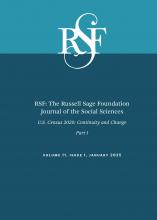Research Article
Open Access
Misalignment of Housing Growth and Population Trends: Cohort Size and Lagging Measurements Through Recession and Recovery
Dowell Myers, Hyojung Lee, JungHo Park
RSF: The Russell Sage Foundation Journal of the Social Sciences January 2025, 11 (1) 86-109; DOI: https://doi.org/10.7758/RSF.2025.11.1.05
Dowell Myers
aProfessor of policy, planning, and demography in the Sol Price School of Public Policy, University of Southern California, United States
Hyojung Lee
bAssistant professor in the Graduate School of Environmental Studies, Seoul National University, Seoul, South Korea
JungHo Park
cAssistant professor, Department of Housing & Interior Design (BK21 Four AgeTech-Service Convergence), Kyung Hee University, Seoul, South Korea

REFERENCES
- ↵
- Aalbers, Manuel B
- ↵
- Acolin, Arthur,
- Jesse Bricker,
- Paul Calem, and
- Susan M. Wachter
- ↵
- Bailey, Martin Neil,
- Aaron Klein, and
- Justin Schardin
- ↵
- Bhutta, Neil,
- Andrew C. Chang,
- Lisa J. Dettling, and
- Joanne W. Hsu
- ↵
- Blinder, Alan S
- ↵
- Campbell, Burnham O
- ↵
- Case, Karl E., and
- Robert J. Shiller
- ↵
- Dietz, Robert
- ↵
- Easterlin, Richard A
- ↵
- Easterlin, Richard A
- ↵
- Flood, Sarah,
- Miriam King,
- Renae Rodgers,
- Steven Ruggles,
- J. Robert Warren,
- Daniel Backman,
- Annie Chen,
- Grace Cooper,
- Stephanie Richards,
- Megan Schouweiler, and
- Michael Westberry
- ↵
- Francke, Marc, and
- Matthijs Korevaar
- ↵
- Frey, William
- ↵
- Fry, Richard
- ↵
- Gabriel, Stuart A., and
- Stuart S. Rosenthal
- ↵
- Gibson, Campbell, and
- Kay Jung
- ↵
- ↵
- Haurin, Donald R., and
- Stuart S. Rosenthal
- ↵
- Himmelberg, Charles,
- Christopher Mayer, and
- Todd Sinai
- ↵
- Immergluck, Dan
- ↵
- Joint Center for Housing Studies
- ↵
- Kuznets, Simon
- ↵
- Lee, Hyojung
- ↵
- Lee, Hyojung
- ↵
- Lee, Hyojung,
- Dowell Myers,
- Gary Painter,
- Johanna Thunell, and
- Julie Zissimopoulos
- ↵
- Lee, Kwan Ok, and
- Gary Painter
- ↵
- Levitin, Adam J., and
- Susan M. Wachter
- ↵
- Mankiw, N. Gregory, and
- David N. Weil
- ↵
- Matthews-Hunter, Keir
- ↵
- Monnet, Eric, and
- Clara Wolf
- ↵
- Myers, Dowell
- ↵
- Myers, Dowell
- ↵
- Myers, Dowell,
- Hyojung Lee, and
- Patrick A. Simmons
- ↵
- Myers, Dowell,
- Gary Painter,
- Hyojung Lee, and
- JungHo Park
- ↵
- Myers, Dowell, and
- JungHo Park
- ↵
- Myers, Dowell,
- JungHo Park, and
- Seongmoon Cho
- ↵
- Paciorek, Andrew
- ↵
- Ruggles, Steven,
- Sarah Flood,
- Matthew Sobek,
- Daniel Backman,
- Annie Chen,
- Grace Cooper,
- Stephanie Richards,
- Renae Rodgers, and
- Megan Schouweiler
- ↵
- Ryder, Norman B
- ↵
- Shiller, Robert J
- ↵
- Shiller, Robert J
- ↵
- Spader, Jonathan
- ↵
- Twenge, Jean M
- ↵
- U.S. Census Bureau
- ↵
- U.S. Census Bureau
- ↵
- U.S. Census Bureau
- ↵
- U.S. Census Bureau
- ↵
- U.S. Census Bureau
- ↵
- U.S. Census Bureau
- ↵
- U.S. Census Bureau
- ↵
- U.S. Census Bureau
- ↵
- U.S. Census Bureau
- ↵
- U.S. Census Bureau
- ↵
- Urban Institute
- ↵
- Wachter, Susan M., and
- Arthur Acolin
- ↵
- Watt, Melvin L
- ↵
- Weisman, Jonathan
- ↵
- Woodward, Susan E
- ↵
- Yu, Zhou, and
- Dowell Myers
In this issue
Misalignment of Housing Growth and Population Trends: Cohort Size and Lagging Measurements Through Recession and Recovery
Dowell Myers, Hyojung Lee, JungHo Park
RSF: The Russell Sage Foundation Journal of the Social Sciences Jan 2025, 11 (1) 86-109; DOI: 10.7758/RSF.2025.11.1.05





